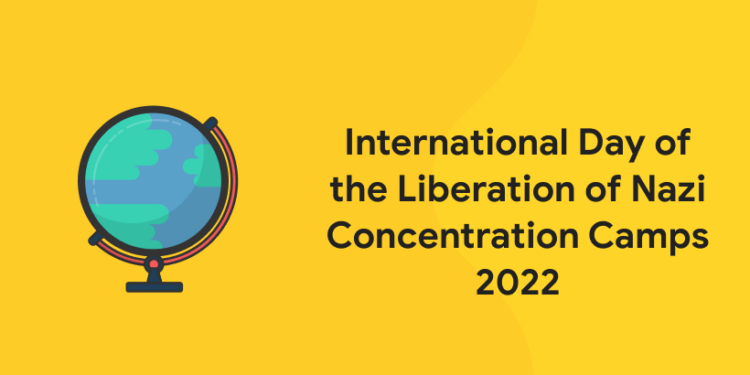Table of Contents
The International Day of Liberation of the Nazi concentration camps is observed annually on 11th April to commemorate the liberation of the Buchenwald concentration camp in 1945. It reminds us of the unspeakable conditions of the Nazi camps and the unhuman treatment of those held captive. Prisoners of Nazis were burnt, poisoned in gas chambers, raped, tortured, starved and forced to work under extreme conditions.
Attempt GK Quiz! Register Here!
International Day of the Liberation of Nazi Concentration Camps History
On January 24, 2005, the UN General Assembly held a special session to commemorate the 60th anniversary of the liberation of the Nazi concentration camps. The special session was prompted by requests from some 30 member states. They stated that “such an evil must never be allowed to happen again” and was the first of its kind.
Liberation of Nazi Concentration Camps
During World War II, Nazi Germany established concentration camps throughout its territories. Germany’s Nazi Party forced hundreds of thousands of people into concentration camps, including political opponents, Jewish people, and other so-called “racially undesirable elements.” The first Nazi concentration camps were established in 1933 but they weren’t liberated until 1944.
Soviet forces were the first to approach a major Nazi camp. They liberated Majdanek camp on July 23, 1944. That was the first major Nazi camp to be liberated. At Majdanek, located in Lublin, Poland, the Soviet troops encountered a number of prisoners who had not been evacuated in the previous spring and also encountered substantial evidence of the mass murder committed by Nazi Germans.
In January 1945, Soviet forces liberated Auschwitz—the largest killing center and concentration camp complex. Weeks before the arrival of Soviet units, Auschwitz camp personnel had forced the majority of Auschwitz prisoners to march westward in what later became known as “death marches.” When the Soviet troops entered the camp, they found over six thousand emaciated prisoners alive. These prisoners greeted the soldiers as their liberators. Here too there was abundant evidence of mass murder. The Germans, before retreating, had destroyed most of the warehouses in the camp. But in those warehouses that remained, Soviet soldiers found personal belongings of the victims. Among these personal items were hundreds of thousands of men’s suits, more than 800,000 women’s garments, and more than 14,000 pounds of human hair.
US forces liberated the Buchenwald concentration camp near Weimar, Germany, on April 11, 1945. The Buchenwald camp was one of the largest Nazi concentration camps, housing prisoners who were used for forced labor in armament factories. When American forces arrived, they encountered more than 20,000 prisoners at Buchenwald. That April, US troops also liberated Dachau, Dora-Mittelbau, and Flossenbürg. They also liberated Mauthausen in early May.
Soviet units liberated additional camps in the Baltic states and Poland. Shortly before Germany’s surrender in May 1945, Soviet forces liberated the Stutthof, Sachsenhausen, and Ravensbrück concentration camps.
British forces liberated concentration camps in northern Germany, including Neuengamme and Bergen-Belsen in mid-April 1945. About 60,000 prisoners, most of who were in critical condition because of a typhus epidemic, were found alive. More than 13,000 of them died from the effects of malnutrition or disease within a few weeks of liberation.
Liberators came to face with the unspeakable conditions in the Nazi camps. They found piles of corpses which lay unburied. The traumatic condition of these camps and the intensity of Nazi cruelty were exposed only after the liberation of these camps. The inmates of these camps who survived resembled skeletons because of the demands of forced labor and the lack of food, compounded by months and years of maltreatment. Disease remained an ever-present danger, and many of the camps had to be burned down to prevent the spread of epidemics. Survivors of the camps faced a long and difficult road to recovery.
Attempt GK Quiz! Register Here!
International Day of the Liberation of Nazi Concentration Camps Quotes
“They brought us into Auschwitz. I could see the chimneys burning, smell the smoke. I did not think about it. They gave us tattoos: 33076. I did not have a name anymore; just a number.” Sara Polonski Zuchowicki, Local Survivor
“The smell was awful — things like that, you do not want to talk about it. Because the pain and memory of suffering comes back to you. You cannot deal with it.” Eva Gryka Kohan, Local Survivor
“She was beautiful, my little sister. You cannot imagine how beautiful she was. They mustn’t have looked at her. If they had, they would never have killed her. They couldn’t have.” Charlotte Delbo, Local Survivor
“Everybody, every human being has the obligation to contribute somehow to this world.” Edith Carter, Local Survivor
“They cannot deprive us of our homes and our fishing boats and our automobiles and lock us up for three years and then just turn us loose into the cities again. They have to help us get a new start.”
Attempt GK Quiz! Register Here!
International Day of the Liberation of Nazi Concentration Camps Quiz
Allied soldiers were direct witnesses to the aftermath of concentration camp horror:
a) True
b) False
Ans: a) True
At which conference did Nazi leaders meet to plan the “final solution” to the “Jewish question”?
a) Wannsee Conference
b) Yalta Conference
c) Casablanca Conference
d) Potsdam Conference
Ans: a) Wannsee Conference
Allied forces were well prepared for what they found in concentration camps:
a) True
b) False
Ans: b) False
There are people today who believe that reports given about atrocities in Nazi concentration camps were exaggerated and even fabricated.
a) True
b) False
Ans: a) True
Which was the first major Nazi camp to be liberated?
a) Majdanek
b) Ohrdruf
c) Auschwitz
d) Stutthof
Ans: a) Majdanek
Which camp was liberated by fourth armored division U.S troops?
a) Majdanek
b) Ohrdruf
c) Auschwitz
d) Stutthof
Ans: b) Ohrdruf
Which camp was the last to be liberated?
a) Majdanek
b) Ohrdruf
c) Auschwitz
d) Stutthof
Ans: d) Stutthof
How many Soviet soldiers were killed during the liberation of Auschwitz?
a) 200
b) 400
c) 600
d) 800
Ans: c) 600
What evidence of the Holocaust did the Allies find when they liberated concentration camps?
a) Hitler’s record log
b) List of officers linked to the camps
c) Bodies, shoes, clothing, human hair etc.
d) They did not find anything
Ans: c) Bodies, shoes, clothing, human hair etc.
Who were the liberators of the concentration camps?
a) Soviet
b) United States
c) Britain
d) All of the above
Ans: d) All of the above
International Day of Liberation of Nazi Concentration Caps is observed on:
a) 11th April
b) 23rd July
c) 12th May
d) 27th November
Ans: a) 11th April
Entri App provides a great online platform for all those aspiring to appear for various bank exams, government exams and other competitive exams. Our team of experts provide short and precise video classes which helps in learning the concepts. Users get access to flash cards and quizzes and can attempt unlimited mock exams with the same pattern as that of the real exams. We also provide PDFs of previous years’ question papers with solutions. Our coaching has helped several PSC aspirants crack the exam.













